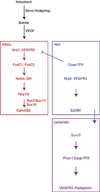Life is a pattern: vascular assembly within the embryo
- PMID: 22202036
- PMCID: PMC3328211
- DOI: 10.2741/541
Life is a pattern: vascular assembly within the embryo
Abstract
The formation of the vascular system is one of the earliest and most important events during organogenesis in the developing embryo because the growing organism needs a transportation system to supply oxygen and nutrients and to remove waste products. Two distinct processes termed vasculogenesis and angiogenesis lead to a complex vasculature covering the entire body. Several cellular mechanisms including migration, proliferation, differentiation and maturation are involved in generating this hierarchical vascular tree. To achieve this aim, a multitude of signaling pathways need to be activated and coordinated in spatio-temporal patterns. Understanding embryonic molecular mechanism in angiogenesis further provides insight for therapeutic approaches in pathological conditions like cancer or ischemic diseases in the adult. In this review, we describe the current understanding of major signaling pathways that are necessary and active during vascular development.
Figures


References
-
- Carmeliet P, Jain RK. Angiogenesis in cancer and other diseases. Nature. 2000;407:249–257. - PubMed
-
- Fraisl P, Mazzone M, Schmidt T, Carmeliet P. Regulation of angiogenesis by oxygen and metabolism. Dev Cell. 2009;16:167–179. - PubMed
-
- Brown A, Barnes J. William Harvey (1578–1657) and Marcello Malpighi (1628–1694): linked in blood, paralleled in life. Adler Mus Bull. 1994;20:14–23. - PubMed
-
- Aird WC. Phenotypic heterogeneity of the endothelium: I. Structure, function, and mechanisms. Circ Res. 2007;100:158–173. - PubMed
-
- Aird WC. Phenotypic heterogeneity of the endothelium: II. Representative vascular beds. Circ Res. 2007;100:174–190. - PubMed
Publication types
MeSH terms
Grants and funding
LinkOut - more resources
Full Text Sources

